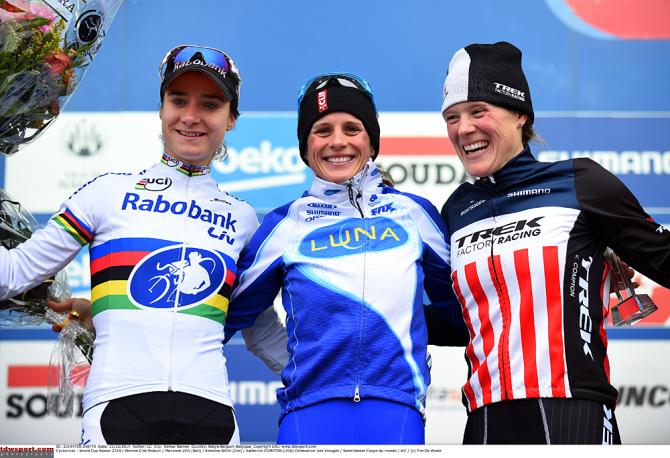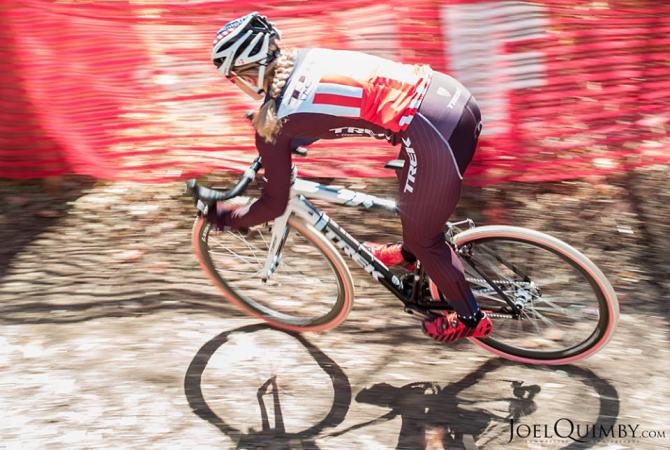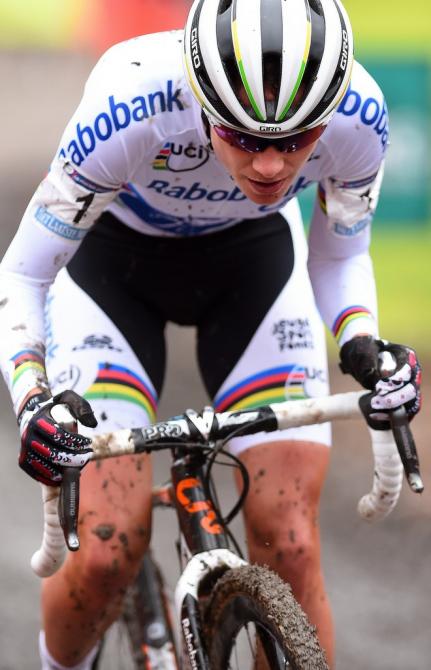Adam Myerson's Inside Dirt: Nash gets it right in Namur
Czech spoils Vos' return, Compton's slow start costs her




Adam Myerson is a professional cyclist and coach who specializes in criteriums and cyclo-cross. A former collegiate national cyclo-cross champion, he began racing as a junior in 1987, and has been a professional since 2003. He is the founder and president of Cycle-Smart, Inc., President of the New England Cyclocross Series, organizer of the Cycle-Smart International Cyclocross, the oldest UCI event in North America, a former member of the UCI Cyclo-Cross Commission, and a former member of the management committee of the International Association of Cyclo-Cross Organizers (AIOC-Cross).
He will be writing a series of blogs for Cyclingnews that break down the key aspects of top-level cyclo-cross races this season. Check out his latest installment about the recent World Cup in Namur.
For being a relatively new race (the first edition was in 2009), and being one of the only Belgian races in Wallonia (most are in Flanders) the Citadelcross in Namur has become an instant classic. It may not be unequivocally the hardest, but the course has all the elements that make ‘cross hard: cobblestones, steep climbs, long unforced runs, half-pipe-like drop offs that are almost drop ins, and mud (often mixed with wet leaves) on almost every surface. The only dry and flat part of the course outside of the finish line is through the pit area, like some dirty trick, forcing riders to dismount to change bikes on one of the few fast and rideable sections.
It’s no wonder that Katie Compton has won the past two editions here. It’s a course that requires brute strength going both uphill and downhill, and very few can match her in that regard. Helen Wyman may climb and run faster, Sanne Cant can bomb descents and rip turns, but Compton can match both their strengths. Her only and well-known weakness is her start, and on a course like this, it’s not typically a penalty. That is, of course, as long as Marianne Vos is not also in the race, and at full strength.
In contrast to Compton, Vos is smaller, lighter, faster to change her speed, more explosive on the short runs and out of the turns. If Compton plows through the mud, Vos floats on top of it. If Compton’s style looks like she’s riding a 40km time trial, Vos’ looks like she’s riding a 50km criterium. Races where the two are able to go head to head, each with their best form, are rare and exciting. Compton was returning to World Cup competition here after a break for training; Vos was beginning her cyclo-cross season at long last. No one really knew what to expect, and neither of them were likely expecting Katerina Nash to upstage them both.
From the start, the race looked to be on a typical script. Off the short, cobbled road and up the first steep, muddy climb, Vos settled in at the front with Eva Lechner eventually leading, while Compton was all the way back in 15th place. Cant, Wyman and Nash were also further back than any of them would have liked, but still well ahead of Compton.
While Lechner got a notable gap quickly, Vos notably closed it and passed her just as quickly. On the first run, Vos shouldered her bike and sprinted up the foot-hole riddled hillside, while Lechner suitcased and struggled. Back in 11th, in traffic, Compton was forced to walk up the hill and wait in line while Vos was already down the other side and sprinting away, 20 seconds ahead, barely two minutes into the race. You don’t win a race in the first lap, but you certainly can lose it, and Compton’s bad start would keep her from ever seeing the front again.
On the Namur course, there are a few key sections: the start, the first climb, the first steep drop off which leads to a left hand turn at the bottom (which eventually claimed Pauline Ferrand Prevot), the long, straight, slightly downhill, off-camber “scooter section,” and finally, the long climb back up to the highest point on the course, part of which was rideable, but for most was a grueling run.
The “scooter section,” so named because the most effective technique in all races (and which decided the winner of the men’s race) was to find a rut, put your wheel in it, lean up the up the hill to the right, and kick your way down and across as if you were on a skateboard or scooter. On the first lap Vos ran this section, but Lechner and most other riders behind her coasted and kicked. Vos gained a second or two, but the energy cost for running the whole thing is massive and unsustainable. On the other hand, getting out of the line and crashing to the left, down the fall line of the hill, is also a big risk (as Ellen Van Loy demonstrated later). Vos continued to run some part of this section throughout the race, while Nash always scootered, certainly adding up as the race went on.
At the end of lap 1, Vos looked like her usual self, off the front and alone, 15 seconds ahead of Nash, with the rest of the top 10, including Compton, in ones and twos behind Lucie Chanel-Lefevre in third. Normally, Vos would just open the gap from this point forward, and even though it was her first race, no one would have been surprised if she did. Nash was not ready to give the race away, however, and as she came onto the pavement, she looked behind her, saw she had a significant gap over the group behind, then turned back around and went to work chasing Vos.
One lap later, Nash was still 16 seconds down on Vos, while Compton was finally in third, 38 seconds down. And so it seemed, again, the gaps would just get bigger, and the race was over early. But gradually and perhaps unexpectedly, Nash caught Vos halfway through the lap, shortly after the off-camber scoot, which Vos once again ran. Nash was noticeably stronger on the climb that followed and where she made contact, and one has to wonder what running the off-camber was costing Vos.
Nash made an excellent tactical decision to pause behind Vos, sit in for half a lap, and evaluate. It didn’t take long for Nash to realize she was the stronger rider. Vos lead over the line at the end of lap 3 with Nash on her wheel, and Compton still 25 seconds down. As they hit the long climb again at the start of the lap, Nash put in a huge attack, and Vos couldn’t hold the pace. It’s a very, very rare sight to see a rider in any discipline attack Vos in a one-on-one situation and Vos not be able to respond. On the other hand, Nash was second here in 2012, behind Compton and ahead of Vos, and so not unprecedented, uncommon as it may be. Certainly, Nash believed in her ability to win.
Vos fought her way back up on the flatter sections of the course, but Nash never relented and continued to put Vos under pressure, to the degree that Vos put her right brake hood into the fence on a muddy straight section on lap 3, snapping the elastic. Vos opted to run the scooter section again, and with that Nash was gone. Lap 4 was Nash’s fastest of the race, in 8:42, and Vos’ slowest, in 9:16.
Ultimately, Vos rode her normal pace for two and a half laps and that was all she had. To be fair, not a surprise for a rider in her first ‘cross of the season, halfway through December, but Vos is so phenomenal we sometimes take top performances from her for granted and unfairly expect her to win everything.
For Compton, once again, the train had left without her at the start, and her diesel engine could only power her up into third. This approach, intentional or not, works in the men’s races for Sven Nys in part because there are always wheels for him to follow, at higher speeds, with more significant drafting, and for a longer period. In the women’s field where there are fewer riders at the front, Compton ends up in the wind chasing much sooner than Nys, who usually doesn’t have to do it until the last 20 minutes of a 60-plus minute race. Compton only has 40-plus minutes to work with, and here she ended up in the wind, alone, after only 10 minutes, with 30 seconds to close, all lost on lap 1. She may, like Nys, be the strongest rider in the race, but a better start would certainly make the task more achievable.
On the last lap, the gaps between riders more or less stayed the same or got bigger, and no significant mistakes were made by the top three riders. Vos settled in to a pace she could sustain, and Compton held the gap behind her. Nash rode like every pedal stroke mattered, standing and sprinting up climbs other riders were sitting and grinding and fighting against. Nash, in a sense, rode the race we might have expected from Compton, albeit with a better start. Cant, the World Cup leader, struggles on the most extreme, physical courses, and while she did so again here like she did at Spa-Francorchamps, she managed to hold on to her leader’s jersey by a single point over Compton.
For Nash, it was an unexpected but popular win by a popular rider. The Czech national and former mountain bike Olympian lives and races in the United States, for a US-based team, and is married to an American. Her wide and high handlebar position resembles her fit on her mountain bike, and the high fives on both sides of the finish straight as she came across for the win couldn’t have been more indicative of that friendly, fan-oriented, grassroots mountain bike spirit, something you almost never see in a European professional cyclo-cross race, but fitting on a course like this. It was the kind of win that makes everyone smile, and certainly, fans of women’s cyclo-cross are smiling at the prospect of having Nash, Vos, and Compton all at the front of the races from now until Worlds. A race, of course, being held in Nash’s home country, on a course where she’s won a round of the World Cup in the past.
The latest race content, interviews, features, reviews and expert buying guides, direct to your inbox!
Adam Myerson is a professional cyclist and coach who specializes in criteriums and cyclo-cross. A former collegiate national cyclo-cross champion, he began racing as a junior in 1987, and has been a professional since 2003. He is the founder and president of Cycle-Smart, Inc., President of the New England Cyclocross Series, organizer of the Cycle-Smart International Cyclocross, the oldest UCI event in North America, a former member of the UCI Cyclo-Cross Commission, and a former member of the management committee of the International Association of Cyclo-Cross Organizers (AIOC-Cross).